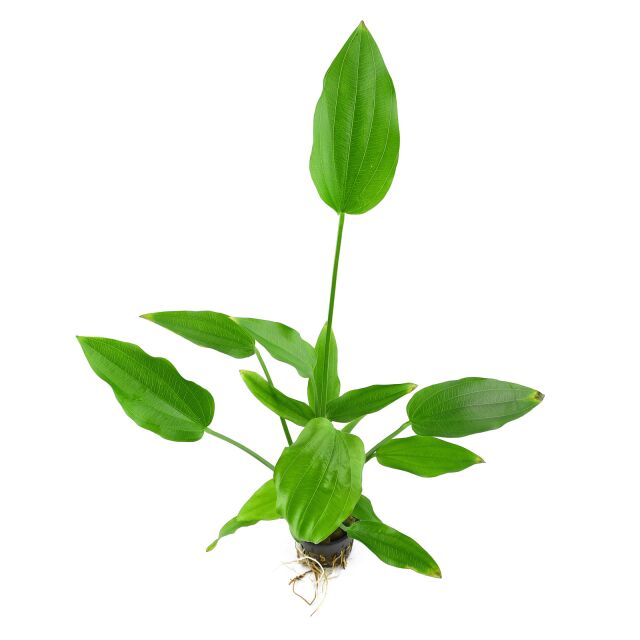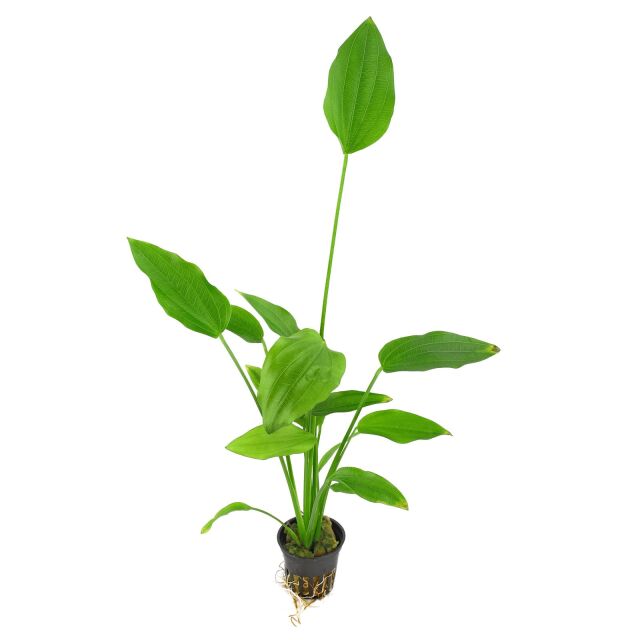Mexican sword plant



Echinodorus palifolius
Mexican sword plant
- Also known as Echinodorus palaefolius
- Tropical water plantain from South America
- Especially suitable for open tanks
- Submerged leaves lanceolate and freshly green
Item question
We’re here for you!
Please enter your question and e-mail and we’ll contact you as soon as possible. It usually takes us up to 24 hours during business days to respond.
Thank you for your question!
Thank you, we’ll get in touch!
Close window
You already sent us a question.
Please wait a few minutes
Description
The "Mexican Sword" is also known as Echinodorus palaefolius and erroneously as "E. rigidifolius" and "E. argentinensis". It is a big, vigorous swamp plant from the hot areas of central and eastern Brazil. This species is closely related to Echinodorus subalatus that differs by narrower, lanceolate leaves. The plant has a strong tendency to grow out of the water. It gets more than 60 cm tall in its emergent form, developing overhanging inflorescences with rather small flowers and adventitious plantlets later on. The submerged plant is about 30 - 40 cm high with freshly green, lanceolate leaves whose petioles are at least as long as the leaf blades.
Echinodorus palifolius is an undemanding, fast growing plant that copes well with higher temperatures beyond 25 °C. Younger plants stay submerged for a longer period, especially with low nutrient amounts. However, older, stronger plants in nutrient-rich substrate will develop long-stalked aerial leaves soon. After removing them the plant will develop submerged foliage again, but emersed leaves will reappear sooner or later. The plant is propagated in its emersed phase by the adventitious plantlets on the inflorescences.
As submerged plant, this Echinodorus wild type has a modest, natural appearance with its lanceolate, freshly green foliage. However Echinodorus palifolius is especially recommendable as emergent plant for open tanks and tall paludaria where it can develop its full potential and also comes to blossom.
Echinodorus palaefolius is often offered in trade, however, it is not often sold under its real name.
A rather acuminately-tipped form quite similar to E. subalatus (fig. 3-5) is called "E. argentinensis" in trade, however, it has nothing in common with true E. argentinensis, which belongs to the E. grandiflorus complex and cannot be found in trade any more (for further information, please see Echinodorus grandiflorus).
Another form often sold under the trade name "Echinodorus rigidifolius" (which is not a valid botanical name) has wide ovate leaves and bulges at the upper end of the leaf stalk (see fig. 1 and 2). The same form, or one very similar to it, is also traded under the name E. palaefolius var. latifolius.
E. palaefolius originates from eastern Brazil and grows as a bog plant in nature. It is closely related to E. (read more)
| Synonyms | Sagittaria palaefolia Nees & Mart., Echinodorus palaefolius (Nees & Mart.) J. F. Macbr. var. latifolius (Micheli) Rataj, Echinodorus palaefolius (Nees & Mart.) J. F. Macbr. var. minus (Seub.) Rataj |
| Misapplied names | Echinodorus argentinensis |
| Trader names | Echinodorus frankoiana, Echinodorus rigidifolius |
| Complete botanical name | Echinódorus palifólius (Nees & Mart.) J. F. Macbr. |
| Family | Alismataceae |
| Genus | Echinodorus |
| Difficulty | very easy |
| Usage | Semi-emersed plant for open tanks, Background |
| Growth | fast |
| Temperature tolerance | 15 - 30°C |
| General hardness | 0 - 30°dGH |
| Propagation | Proliferating inflorescences, Rhizomteilung, Splitting, cutting off daughter plants |
| Can grow emersed? | yes |
| Source | Flowgrow |
| Synonyms |
| Sagittaria palaefolia Nees & Mart., Echinodorus palaefolius (Nees & Mart.) J. F. Macbr. var. latifolius (Micheli) Rataj, Echinodorus palaefolius (Nees & Mart.) J. F. Macbr. var. minus (Seub.) Rataj |
| Misapplied names |
| Echinodorus argentinensis |
| Trader names |
| Echinodorus frankoiana, Echinodorus rigidifolius |
| Complete botanical name |
| Echinódorus palifólius (Nees & Mart.) J. F. Macbr. |
| Family |
| Alismataceae |
| Genus |
| Echinodorus |
| Difficulty |
| very easy |
| Usage |
| Semi-emersed plant for open tanks, Background |
| Growth |
| fast |
| Temperature tolerance |
| 15 - 30°C |
| General hardness |
| 0 - 30°dGH |
| Propagation |
| Proliferating inflorescences, Rhizomteilung, Splitting, cutting off daughter plants |
| Can grow emersed? |
| yes |
| Source |
| Flowgrow |
General information
Please choose a variant to see more information.
| Item no. |
|
| EAN | |
| Weight | |
| Shipping weight |
Customers ask customers
You have questions about this product? Ask other customer or our support team about this product!